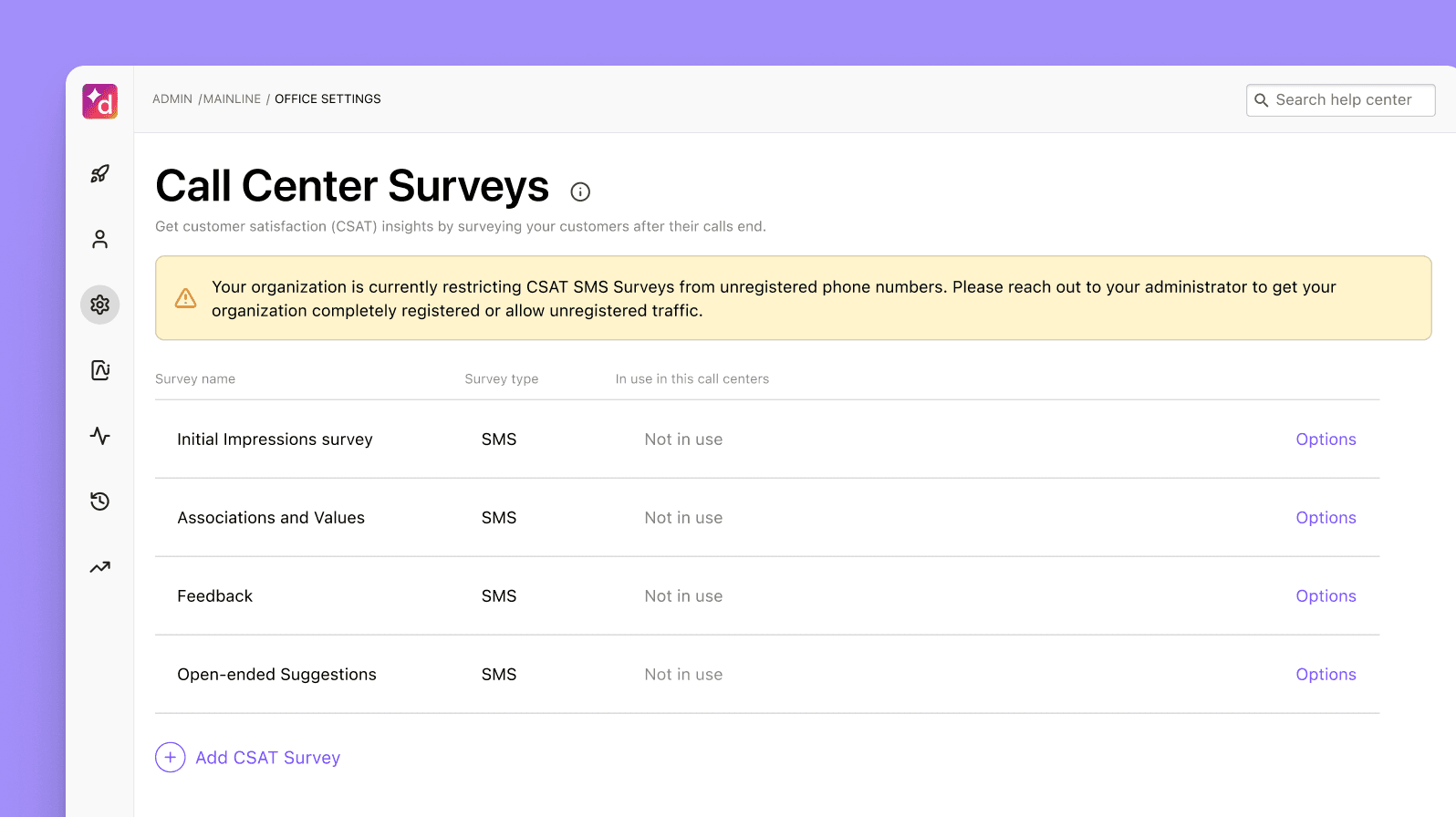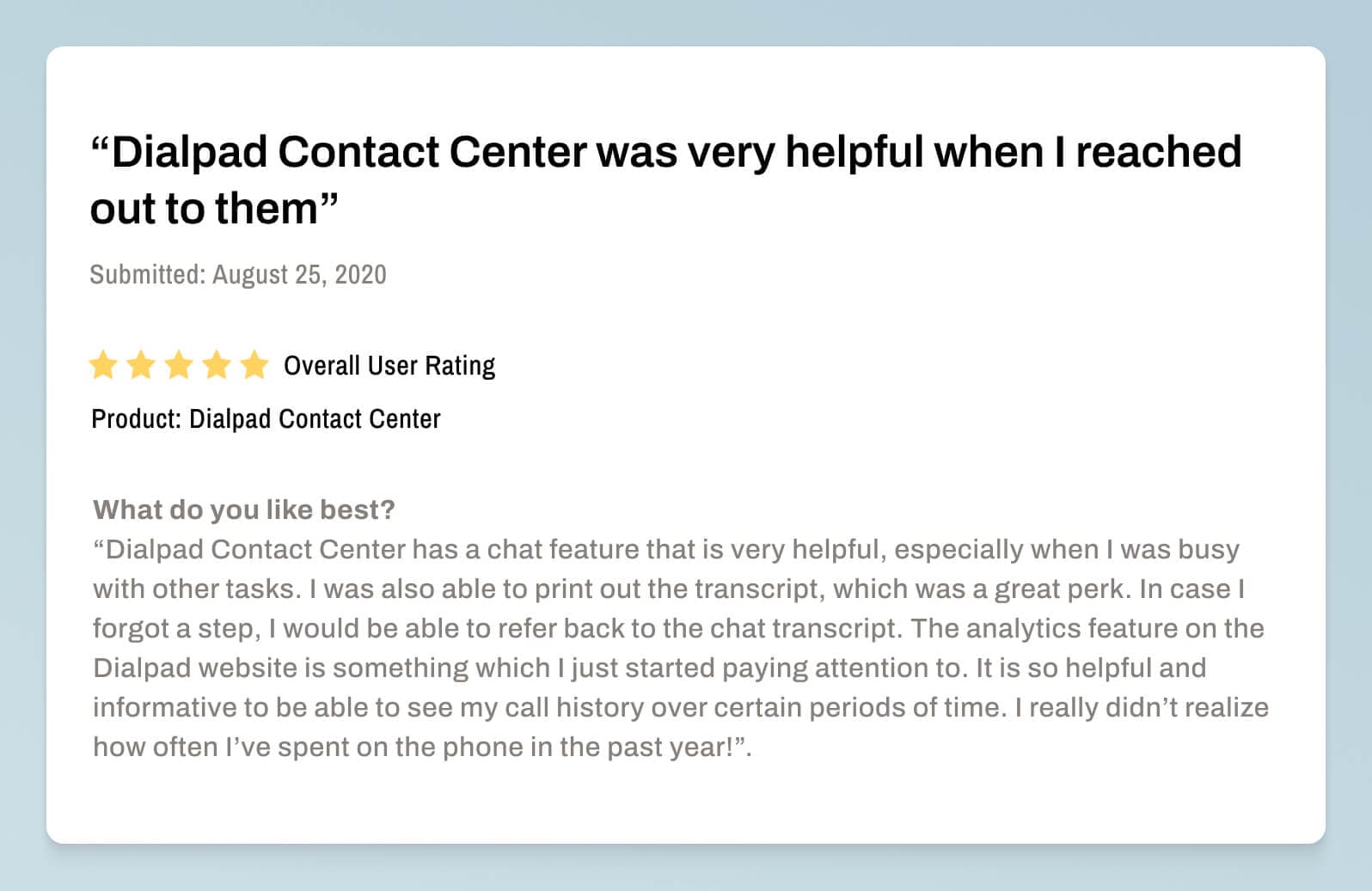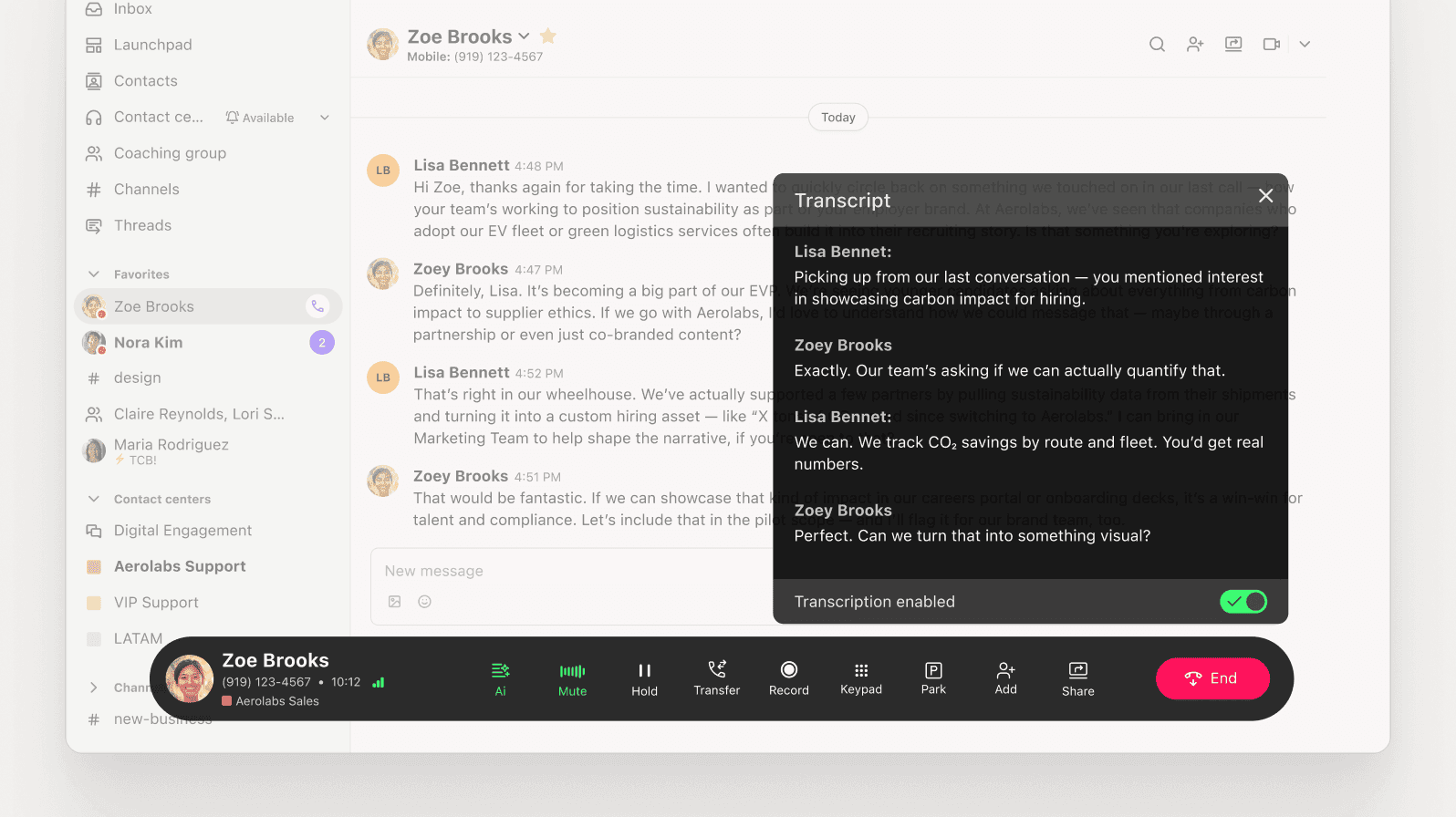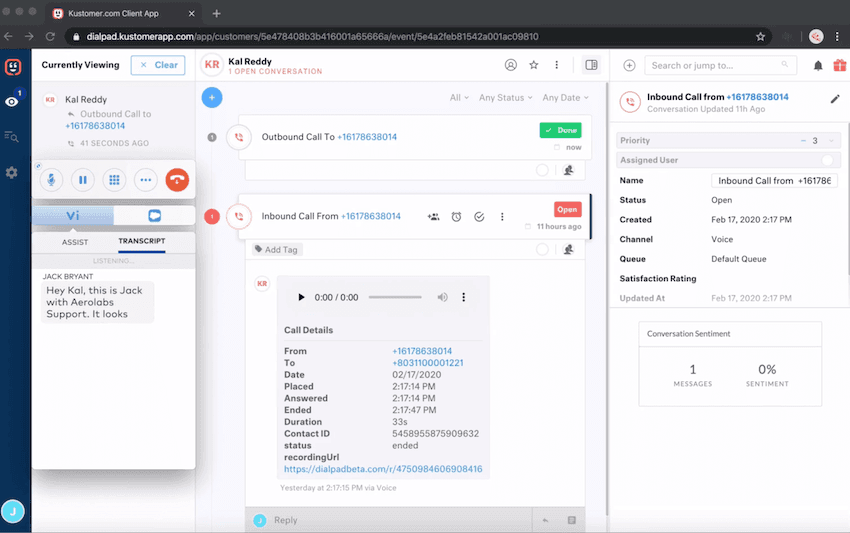Voice of the Customer: An in-depth guide
Need a better way to gather customer insights and build a Voice of the Customer programme? Dialpad AI Contact Centre is designed to help supervisors track topics that come up on customer calls, understand call sentiment in real time, and more. See how it works with a demo!

Having a well-oiled, functioning support team is always essential—more so now than ever. But, that team alone shouldn't be the only one expected to care about customer support—it should be a company-wide effort.
A Voice of the Customer (VoC) programme can help improve customer support across your organisation and ensure your support efforts are driven by genuine customer needs, opinions, and preferences.
In this guide, we’ll go over what VoC is, what a VoC programme looks like, and techniques and tools you can use to create your own.
What is Voice of the Customer (VoC)?
Sometimes also known as “Voice of Customer” or “Voice of the Consumer”, and Voice of the Customer (VoC) programme is a strategic approach to collecting, analysing, and acting upon customer feedback. As such, it’s made up of many moving parts.
Together, these parts give you a blueprint to collect customer feedback—and analyse it—in different ways. Every company’s Voice of the Customer programme is different, and you need to find the method that works best for your business, whether that's through CSAT, NPS, CAB (customer advisory boards), QBRs, or something else.
The feedback you collect, or VoC data, helps you understand your customer’s feelings about your business, product, or service. And these insights are crucial in your quest to build a customer-centric experience.
How Voice of the Customer benefits your customer experience strategy
So, why is Voice of the Customer important as an approach for modern businesses? Because, it can help your organisation in a range of different ways:
It provides insight into customer’s motivations and desires
A well-executed VoC programme can give you an understanding of customer's motivations and desires. Without one, you'd have no idea how they felt about any part of your product or service.
With VoC, you know what's motivating your customers and what they want from your company, giving you the best opportunity to revitalise the customer experience.
It helps identify and prevent brand crises
Keeping an eye on what your customers are saying helps you to identify and prevent brand crises. By monitoring minor issues, you'll be better prepared for the larger problems looming on the horizon.
In a crisis, use VoC to monitor customers' reactions to your response. This will give you an idea of how you're handling the problem and whether your customers feel you've addressed the crisis satisfactorily.
It allows customer service to proactively solve problems
Customer service can use VoC to anticipate and solve customer problems before they escalate. For example, if you learn from customer feedback that password reset requests aren't being delivered to customers' emails, customer service can automatically push the emails to affected customers before they even reach out for help.
It helps test and evaluate new campaigns, products, and services
Have a new product update with lots of new features? Ask your customers what they think of the new ideas before investing in a full product development lifecycle. This will give you an idea of what will work with your base and what's not worth pursuing.
It boosts customer acquisition and retention
If you can use a Voice of the Customer strategy to deliver a quality product or service that customers can depend on, they’ll stick with you.
Customers that can depend on a company will remain loyal, boosting your customer retention. That's good for your business and your bottom line. Loyal customers are also more likely to spread the word about your business to family and friends.
It helps your deliver what your customers really want
VoC connects you directly with the customer, so you can gauge how they think and feel about your business, what needs to be fixed, and what they actually want.
With direct information from the customer, you can understand better why they value your product and how it helps them. From there, you can tailor your product or service to give your customers what they truly want.
What makes up a Voice of the Customer programme?
There are typically two main things to consider when you’re running a VoC program: how you’re going to collect that feedback from customers, and how you’re going to use it.
Collecting feedback from customers
As technology develops and connects you to your customers in a range of different ways, the range of methods for collecting feedback also multiplies.
Here are just a few alternatives and how Voice of the Customer software features can help along the way:
CSAT
Quantitative methods are an underrated way to evaluate customers’ experiences (everyone tends to obsess over numbers), and customer satisfaction surveys (CSAT) are one of the best tools available. CSAT surveys measure customer satisfaction with your product or service by collecting feedback directly from the customer.
To do a CSAT survey, you typically need to call a customer, send an email, or reach out through another channel and ask them to give you a CSAT score. It’s a pretty commonly used metric and is generally one of the first feedback methods that many businesses implement.
With Dialpad, for instance, you can create a CSAT survey, customise the survey question, and have it play automatically at the end of a call. Your customer can then punch in the score they want to give you on their phone:

This is a key part of getting the complete picture of your customer experience—while the experience is still fresh in the customer's mind.
In fact, with Dialpad, you don’t even need completed surveys to collect CSAT scores. As an example of how customer service AI is making all kinds of processes simpler, Dialpad’s AI CSAT feature can generate accurate CSAT scores based on deep learning models.
NPS
NPS surveys are another type of survey that you can use to measure how you’re performing against customers’ expectations and how strongly they feel about your company's products, services, and/or support. These tell you how likely a customer is to promote your business to their network, and can also be a good indicator of customer loyalty.
Customer effort score (CES)
Your CES score tells you how easy or difficult it was for a customer to get a certain thing done. (It might be to sign up for your service, to get a question answered…)
This tells you if there are any gaps in your customer journey or pain points that you need to fix in order to provide a good experience for your customers.
Customer Advisory Board (CAB)
A customer advisory board (CAB) comprises a group of high-level stakeholders who meet on a semi-regular basis to share their opinions and advice with a company. CAB roundtables are a great way to not only get valuable insights from your customers, but also help your customers build a sense of community with each other.
Integrating your VoC programme into team processes
Most folks assume that VoC is owned and operated just by the Customer Support or Experience team, but really many different departments have a hand in Voice of the Customer data!
Product Development, Marketing, Customer Support—any internal departments that can impact the customer, good or bad, can be part of the VoC program.
Professional Services
Professional Services teams typically help customers get set up with new software and integrate complex products and solutions into their everyday workflows with expertise and guidance tailored to the customer.
For example, if a company purchased a CRM, the CRM's Professional Services team would help onboard employees to that new CRM, ensuring a smooth adoption across the organisation. They’d probably have valuable customer insight about how they’re using products, and what they need to be successful.
Customer Support
Customer Support teams are constantly building rapport with customers and getting feedback. Customer care is a central part of their role. They use surveys to see how new customers feel about the product and other specific issues, including the more technical questions.
Customer Marketing
A CAB programme (or customer champion program) can be an excellent resource for customer feedback. Your Customer Marketing team can handle a CAB programme or other market research processes designed to ask questions and collect feedback.
Ownership by internal teams
It’s not just about how teams can work individually to implement your VoC programme, either. Ask yourself, how are my teams interacting as partners? What does VoC mean in business, after all, if not the cohesive attempt to make your whole organisation more customer-centric?
The most successful VoC programs are co-owned collaborations. If it's a shared program, it's more of an equal conversation. The Product team alone can't own VoC because that limits the feedback to the product and innovation side when in reality, you're looking for all interactions, not just when the product or service is being used.
✨ UPLEVEL YOUR CONTACT CENTRE
Grab the Contact Centre Playbook, which breaks down everything you need to know, from setup to staffing to optimising—with examples from real contact centre teams across different industries.
Applying VoC in business: 5 steps to create your own program
There’s no one-size-fits-all approach to a VoC programme. However, if you look at Voice of the Customer examples that work in practice, many of them share some hallmarks. The following are five steps to follow when setting up your programme to help ensure it will, too:
1. Outline your objective or question
Before creating your VoC program, come up with a question and an objective for your efforts. If you reach out to customers for data with an objective in mind, it’ll make it easier down the road to actually apply the information that you gather.
The question can be about anything—customer behaviours, past performance, trends—it’s only meant for you and anyone else who needs to see them. Here are some ideas to base your questions off of:
Gauging current performance: Measure your current performance to establish a starting point for your business that can be used as a reference down the road.
Improving a current product or service: Choose this option to understand your customer’s needs better and improve your product or service.
2. Identify relevant customer groups
Customer groups are any internal groups that have insights into the actual customer (not just your support team).
Map out your customer journey, go through it, and note any internal teams that have frequent customer interactions. Each of these departments should be encouraged to share their customer feedback so you know what VoC should address.
Interview a sample of team members from each group to get an idea of what's working for the customer and what issues are brought up repeatedly.
3. Gather VoC feedback and data
It’s data collection time! Typically, there are two main channels you can use to gather VoC data: active and passive channels.
Active: This is feedback you ask for from your customers. This may include customer surveys, focus groups, and/or customer interviews. An example of an active feedback method would be the CSAT surveys we mentioned above.
Passive: This is feedback you get from customers proactively reaching out to your company—you’re just passively receiving it. You will, however, need to monitor customer interactions regularly to discover any customer insights. You might collect this feedback in your live chat conversations, social media reviews, and call data.
Dialpad’s artificial intelligence technology, Dialpad AI, for example, is designed to help with this. In just one of many ways you can leverage the Dialpad platform as VoC software.
We mentioned that it can transcribe calls, but you can also set specific keywords or phrases to be tracked by Dialpad AI. For example, if you’re interested in what customers say about a certain feature—say Feature X—then you could set “Feature X” as a Custom Moment in Dialpad:

This will then tell Dialpad to track every time Feature X comes up in a customer call—which you can see over time in your analytics dashboard, and use that information to dig into specific calls to understand the context behind why Feature X comes up in calls!
4. Analyse the results
Identify patterns in data collected
Once you've collected all your data, you can start to look through it for trends and common themes. What are your customers asking for or commenting on the most? Look at the numbers of customers that responded and prioritise based on those percentages.
Compare the findings against your objectives or questions
Look back at your business goals, the objectives you set for your VoC programme, and the questions you asked your customers. Compare the feedback you received and see how they stack up against what was asked.
Pinpoint any strengths to build upon and/or areas for improvement
Analyse your feedback and see where customers praised your product or service—these are strengths you’ll want to build on, and even though this is important, it’s generally better to prioritise the areas where you need improvement first.
5. Implement changes to your product/service
Reevaluate existing products/services in their areas for improvement
If you get feedback about one part of your business, evaluate that area in detail and how it relates to the product or service to eliminate any other problems before they become an issue.
Balance your customers’ needs with your business goals
Evaluate the need, cost, and time implementing a change to your product or service will mean. Does the change align with your business goals? The change should work for you and the customer.
Consider a closed-loop customer feedback system
Always, always circle back directly with customers if you can, to let them know their feedback has been heard and acted upon. It's a great way to fine-tune your customer engagement strategy, improve the customer experience, and encourage them to provide more useful feedback in the future.
Voice of the Customer best practices for implementation
Above, we’ve given you some tips for creating a VoC programme and a few VoC tools to help you on your way. But, what about the practicalities of implementing your programme? Here are some best practices to keep in mind:
Don’t over-engage your customer
Customer surveys are critical to run an efficient business, but your customers are busy and can’t spend all their time giving you feedback.
For example, a customer might get a survey after the VoC programme is implemented. Then, they might call your contact centre for help, resulting in another survey when the support ticket is opened.
If customers feel like they're getting asked to do surveys every five minutes, they'll get annoyed. We're all inundated with surveys from companies we interact with—survey saturation is real.
Make sure the feedback you collect is actually acted upon
If you're asking for feedback and collecting data from customers, then you have to show you're acting on it. If you show your customers the actions you're taking based on their feedback, they'll know you're walking the walk, not just talking the talk.
Base the frequency of gathering feedback on customer usage and touchpoints
Some customers will use your product or service 40 times a day, while others will use it only three times a week. Basing feedback frequency on customer usage and specific touchpoints is your best bet.
For example, if a customer has logged in every day for the last three weeks, leverage your business text messaging or send an in-app message. If a customer calls into support and a ticket is opened, and a survey is sent, wait at least seven days before reaching out again.
7 Voice of the Customer methods and tips for keeping your programme running smoothly
So, now you’ve got your VoC programme up and running and have some Voice of the Customer solutions implemented. How do you keep it running smoothly?
1. Conduct customer interviews and focus group discussions
Customer interviews are an excellent way to understand customers' views on products or services. You can interview customers in person, on the phone, or via video conference.
Customers find one-to-one interviews more personal, so this method has the added benefit of improving individual customer relations.
Focus groups, like some interviews, are done in person and usually involve a small group of customers. Traditionally, a moderator organises a group of customers and discusses the brand, product, or service. A focus group's back and forth discussion style is excellent for providing insights that may have never been voiced before.
2. Survey customers both in-person and online
To get the answers you need, you need to ask the right questions in the correct format.
Online surveys present all kinds of design options. What kind of question format is best for your needs? Consider the design of your surveys and choose an easy format for you and your customers to process.
In-person surveys aren't as common, but many smaller and medium-sized businesses use them to conduct customer research. Have customers fill out a survey while they wait for a service, or have team members conduct short customer surveys while they're assisting customers.
3. Keep an eye on customer reviews
When considering a new product, service, or business, the first thing people do is to search online for reviews. Review sites like TrustRadius, G2, Capterra, and reviews on Google, give potential customers a chance to see what people think of your business:

Negative online reviews can discourage people from doing business with you, so it's imperative to handle these. Respond promptly and address the customer's bad experience specifically. Follow this experience up across your team to ensure that the same mistakes aren’t made again. Feed back your actions to the customer, so they feel heard and valued.
4. Measure and monitor your Net Promoter Score (NPS)
NPS metrics are a great way to measure the happiness of your customers. Most consumers are familiar with the "on a scale of one to 10" format.
Depending on the number of responses you get, you'll be able to gauge where you stand with your customers. If you have a lot of responses at five and below, you could be at risk of high churn; it's time to revisit your customer service strategy and make some improvements.
5. Implement feedback forms wherever possible
No matter what form you choose to capture VoC, make sure it's widely available to customers. You want providing feedback to be as easy as possible. Empower your customers to offer feedback on their own terms at any time.
Have a feedback form on your website that's easy to find from your home page so customers can easily leave feedback. Run A/B testing of different survey templates to see which option performs best with customers.
6. Interview customer-facing employees
Customer-facing employees interact with your customers daily, making them an invaluable resource for VoC.
Your Support team will have information about product or service issues that are becoming widespread. They'll be able to report on technical glitches and product malfunctions.
Your Sales team can offer viewpoints on why customers are hesitant to purchase your products, why prospects go to competitors, and what features they’re looking for.
7. Map customer behaviour and UX on your website
Analysing customer behaviour from data collected on your website is a great way to see how people interact with your content. Instead of analysing what customers say, you can analyse what they do by improving your understanding of the customer experience.
Mapping customer behaviour helps you know what's working on your website and what can be improved. You can see what pages customers visit the most and how much time they spend on specific product pages.
Voice of the Customer tools to support your programme
When we’re talking about Voice of the Customer solutions, we don’t necessarily mean a dedicated, specialist Voice of the Customer platform. What we mean are tools and pieces of software you can use for the nuts and bolts of VoC programmes—collecting, analysing, and acting upon feedback.
So, here are some suggestions of tools to support your VoC efforts:
A tool for capturing customer insight or feedback
This is one of the most important pieces of a VoC programme. Whether you’re getting feedback in phone calls or messages, you need some way to capture that information.
For example, Dialpad is an AI-powered customer engagement platform that has a built-in AI technology that transcribes calls—in real time:

It’s called Dialpad AI, and can transcribe more accurately than almost all leading competitors.
All transcripts are searchable, which means that if you remember only a piece of what a customer told you, Dialpad AI lets you search your call transcripts for specific keywords so you can find the right piece of feedback.
Not only that, Dialpad AI can also do live sentiment analysis based on keywords used during conversations in real-time:

A system of record
A system of record is a must for any business—the right solution can organise all of the data your company produces and store it so it's easily accessible. Once a system of record is implemented into your workflow, it will be the backbone of your operations.
CRM
A CRM, like Salesforce, can help you keep track of every customer interaction and manage customer accounts. Logging activities manually can be a huge time-waster and takes agents away from high-value tasks like helping customers solve challenging problems.
Having a CRM that’s integrated with a communication platform lets your team take detailed notes company-wide, so everyone knows exactly what's happening with each customer.
For example, Tecovas, a Western boots and accessories brand did exactly this. The company experienced an explosion of popularity a few years ago, but as they expanded and demand for their product grew, customers and agents alike grew frustrated with the siloed support functions.
Agents couldn't see customer information all in one place, so if a customer reached out more than once, different agents would respond with different information—not good.
Tecovas needed a contact centre solution to organise customer data better, reduce agent collision, and provide seamless voice support. So how did they fix it?
They used Kustomer, a customer service-focused CRM platform that integrates with Dialpad to provide a unified customer view for agents on every call:

Dialpad's Kustomer integration meant that Tecovas's agents could use Dialpad's cloud contact centre solution (with built-in telephony) and Kustomer's CRM capabilities to see customer information in one place—while making crystal-clear calls.
"With our previous contact centre solution, you could only hear every other word that a customer was saying," said Carli, Head of Customer Success at Tecovas. "The customer would have to call back, and the agent would be unable to offer assistance despite being there to help...Dialpad, on the other hand, is reliable and customisable. Agents can focus on delivering great service without distractions."
Ready to implement a Voice of the Customer programme?
A VoC programme isn’t just a tool to help you grow your business and increase revenue. In times like these, the Voice of the Customer is imperative to your business success.
It’s a way to engage with your customers and see how your product or service works for the customer. It’s a chance to hear directly from the source what your customer wants and what you could be doing better. But most importantly, it’s a chance to connect with your customer and build a relationship.
Gain more insight into customer conversations
Book a demo of Dialpad's AI-powered customer engagement platform, or take a self-guided interactive tour of the app on your own!
